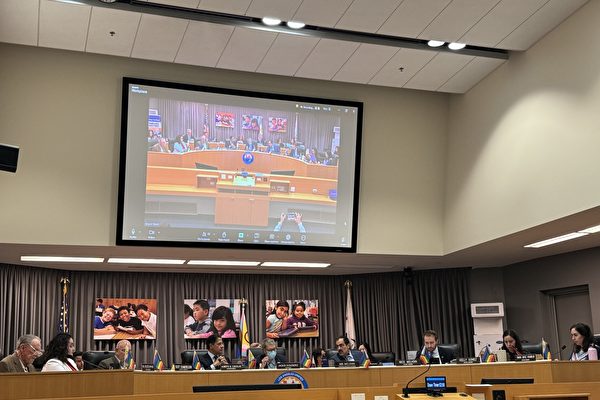In order to reduce the negative impact of smartphones and social media on children, the Los Angeles Unified School District (LAUSD) Board of Education passed a proposal on June 18 (Tuesday) to prohibit students from using smartphones during school hours.
LAUSD is the second largest school district in the United States, with 1,322 schools and over 600,000 students. During the district meeting on Tuesday, the Board of Education approved the smartphone ban with a vote of 5 in favor and 2 against.
Supporters of the ban believe that prohibiting phone use during school hours can not only improve the learning environment but also promote children’s physical and mental well-being, shielding them from the negative influences of online content.
“Our students are addicted to phones,” said board member Nick Melvoin during the meeting. “Unlike adults, they sneakily use their phones in class… They no longer talk to each other, nor interact or play during lunch or break time because they are all wearing headphones.”
With increasing concerns about the negative impact of social media on children’s mental health, including increased depression and anxiety, decreased attention span, and technology addiction, this ban has garnered support from many educators and parents.
However, some parents have expressed opposition to the ban out of worries about not being able to reach their children in case of emergencies. The two board members who voted against the ban also raised concerns about potential challenges and complications in enforcing the ban.
While the proposal has been passed by the Board of Education, it will not take immediate effect. The district will have 120 days to devise detailed guidelines and finalize the new policy at the meeting in January 2025 before it officially goes into effect. During the process, students and parents will be adequately informed about the ban and feedback from all parties will be collected.
The proposal to prohibit students from using smartphones during school was initiated by Melvoin, Board Chair Jackie Goldberg, and member Tanya Ortiz Franklin. They cited medical research demonstrating the harm of social media on students’ physical and mental well-being.
Melvoin also mentioned that LAUSD already had a similar policy in place but it was never formally implemented. Therefore, the new ban serves as a consolidation measure and relieves teachers of the burden of enforcement.
He suggested that schools could enforce the ban by installing phone storage lockers or distributing phone pouches, and the district could establish platforms that restrict access to social media.
Addressing parents’ concerns about not being able to contact their children in emergencies, Melvoin proposed that each school set up communication channels managed by adults to ensure clear and accurate information is conveyed, alleviating parental anxiety.
Goldberg highlighted that many drugs are illicitly sold through social media platforms, leading to fatal consequences when consumed by students; she also expressed concerns that excessive phone use could impair teenagers’ face-to-face communication skills.
She described a scene she witnessed during a recent visit to a high school where students sat face-to-face at lunch tables but communicated through messages on their phones, unwilling to engage in conversation.
“This is a serious addiction phenomenon that is eroding our children,” Goldberg said during the meeting. “To stop students from further addiction, at least during school hours, they must not use phones from entering to leaving school.”
The majority of the speakers at the meeting expressed support for implementing the smartphone ban, including a high school student in the district named Thakkar.
Thakkar told reporters, “I support this idea. I know phones are very harmful to mental health and I see everyone getting distracted in class because of phones; personally, I also get distracted during classes because of this.” He believes that “the idea of banning phones during school hours falls completely within the district’s jurisdiction and is reasonable.”
However, he acknowledged that the ban is likely to face opposition from students during implementation. He suggested that the Board of Education establish a platform for students to voice their opinions for mutual communication.
Board members George McKenna and Scott Schmerelson voted against the ban.
McKenna expressed concerns that enforcing the ban would be challenging for teachers and students and that students’ rights should not be restricted. He felt that the comprehensive ban did not receive an opportunity for open discussion and voted against it in the absence of data and reports supporting potential impacts of the ban.
Schmerelson stated that the district lacks sufficient management personnel, and it can be anticipated that there will be a severe shortage of staff in implementing the ban. He also emphasized the importance of distinguishing between instructional and non-instructional times, suggesting that students should be allowed to use phones during specific periods like lunch.
Regarding the final decision made by the Board of Education, LAUSD Superintendent Alberto Carvalho expressed his support. He informed reporters that the proponents and supporters of the proposal had negotiated the ban’s content with unions, including teachers, principals, administrators, and all departments; consultations were also held with student groups, parent organizations, and medical researchers.
He also believed that excessive use of social media had been proven to cause a mental health crisis, especially more harmful to young people, as “social media is designed with powerful algorithms using predatory language and images to captivate young people and make them addicted.”
Carvalho praised the district for taking bold steps to address the influence of phones and social media on young people.

